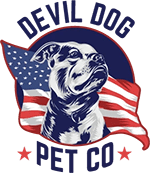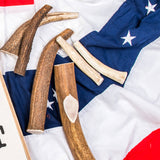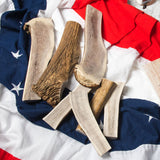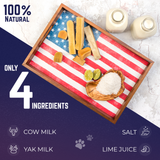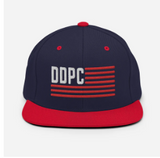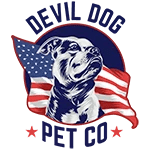What Are Cow Ear Chews?
Walk into any pet store and you'll find shelves packed with processed chews loaded with chemicals and fillers. But smart dog owners are returning to what works: simple, natural options that actually deliver on their promises. Cow ears for dogs represent exactly this kind of back-to-basics approach—single-ingredient chews that have kept working dogs satisfied for generations.
Key Takeaways
- Cow ears for dogs are naturally dried, single-ingredient chews made from cattle ears.
- They provide high protein, low fat nutrition while supporting dental health.
- Cow ears satisfy dogs' natural chewing instincts and are generally safe when given in moderation and under supervision.
- These chews offer a simple, natural alternative to processed treats with chemicals and fillers.
- Cow ears have been a trusted chew option for working dogs for generations.
Table of Contents
These naturally dried chews come from the ears of cattle, typically processed through slow dehydration that preserves nutrients while creating the perfect texture for sustained chewing. Unlike synthetic alternatives or heavily processed treats, quality cow ears contain nothing but the ear itself—no artificial preservatives, no chemical additives, just pure nutrition your dog can actually use.
You'll find cow ears available in two main varieties: hair-on and hair-off. The hair-on option isn't just rustic packaging—it serves a purpose. That natural hair acts as a gentle digestive aid, helping sweep the intestinal tract clean while providing additional fiber. Think of it as nature's own cleaning system, something our dog Dexter discovered when he first encountered these chews during his puppy days.
Why Are Cow Ears Popular for Dogs?
The appeal comes down to three factors: effectiveness, safety, and simplicity. Cow ear dog treats hit that sweet spot between durability and digestibility that most synthetic chews miss entirely. They're tough enough to satisfy aggressive chewers but won't splinter like rawhide or damage teeth like some harder alternatives.
Here's what separates cow ears from the competition: they actually break down safely in your dog's system. While rawhide can sit in the stomach for hours or even days, cow ears digest efficiently because they're real food, not processed leather. This digestibility factor makes them suitable for dogs with sensitive stomachs or those prone to blockages.
Pro Tip: The natural cartilage in cow ears provides chondroitin, a compound that supports joint health—especially valuable for active dogs or aging seniors dealing with mobility issues.
The texture also delivers exactly what most dogs crave: a satisfying crunch that gradually gives way to a more pliable chew. This progression keeps dogs engaged longer than softer treats while providing the mechanical action needed to scrape plaque from teeth and massage gums.
For owners dealing with destructive chewing behaviors, cow ears dog treats offer a productive outlet. Instead of watching your dog demolish furniture or shoes, you can redirect that energy toward something beneficial. The extended chew time—typically 30 minutes to several hours depending on dog size—provides mental stimulation that helps reduce anxiety and boredom.
Most importantly, cow ears work for virtually every dog size and breed. Small dogs can work on appropriately sized pieces, while larger breeds can tackle full ears. This versatility, combined with their hypoallergenic properties, makes them a go-to choice for multi-dog households or owners dealing with food sensitivities.
Nutritional & Health Benefits

Key Nutritional Highlights
When you examine the nutritional profile of cow ears for dogs, you'll discover why veterinarians and canine nutritionists consistently recommend them over processed alternatives. These single-ingredient chews pack impressive nutritional density into a format dogs actually want to consume.
The protein content stands out immediately—cow ears typically contain 70-80% protein by weight, making them an excellent supplement for active dogs or those recovering from illness. This isn't just any protein; it's complete protein containing all essential amino acids your dog needs for muscle maintenance, immune function, and cellular repair.
Fat content remains refreshingly low at just 8-12%, a stark contrast to pigs ear dog treats which can contain 20-30% fat. This makes cow ears ideal for overweight dogs or those with pancreatitis who need to limit fat intake while still enjoying satisfying chews. The low-fat profile also means less mess on your floors and furniture.
Nutritional Comparison: A single cow ear contains approximately 120-150 calories, compared to 200-250 calories in a pig ear of similar size. This calorie efficiency allows for more frequent treats without disrupting your dog's diet balance.
The mineral content tells an equally compelling story. Cow ears naturally provide zinc for skin and coat health, selenium for immune system support, and phosphorus for bone development. These aren't synthetic additives—they're naturally occurring minerals that your dog's body readily absorbs and utilizes.
Digestibility and Allergies
Unlike rawhide or synthetic chews that can cause digestive blockages, cow ear dog treats break down completely in your dog's digestive system. The natural collagen structure softens with saliva and stomach acid, allowing for smooth passage through the intestinal tract.
For dogs with food sensitivities, cow ears offer a hypoallergenic alternative to common protein sources. Beef allergies in dogs are relatively uncommon compared to chicken, wheat, or soy sensitivities, making cow ears suitable for most elimination diets. The single-ingredient nature eliminates the guesswork—you know exactly what your dog is consuming.
Dental Health Support
The mechanical action of chewing cow ears provides significant dental benefits that go beyond simple entertainment. As dogs gnaw on the naturally textured surface, they're essentially brushing their teeth with nature's own dental tool.
The fibrous structure of cow ears acts like a natural toothbrush, scraping plaque from tooth surfaces while massaging gums to improve circulation. This mechanical cleaning action reaches areas that traditional brushing often misses, particularly the back molars where tartar tends to accumulate.
Research indicates that dogs who regularly chew appropriate natural chews show 60-70% less tartar buildup compared to those without chewing enrichment. The extended chew time—typically 45 minutes to 2 hours depending on dog size—provides sustained dental cleaning that brief treats simply can't match.
Joint Health and Mobility
The cartilage component in cow ears delivers naturally occurring chondroitin sulfate, a compound that supports joint health and mobility. This isn't a synthetic supplement—it's the same joint-supporting compound found in expensive veterinary supplements, delivered in a format your dog actually enjoys.
For aging dogs or active breeds prone to joint issues, regular consumption of cartilage-rich chews like cow ears can provide ongoing joint support. The glucosamine and chondroitin work together to maintain cartilage integrity and reduce inflammation in joints.
| Benefit Category | Cow Ears | Pig Ears | Rawhide |
|---|---|---|---|
| Protein Content | 70-80% | 60-70% | 85-90% |
| Fat Content | 8-12% | 20-30% | 1-3% |
| Digestibility | Excellent | Good | Poor |
| Allergy Risk | Low | Moderate | High |
| Dental Benefits | High | Moderate | Low |
| Joint Support | Yes | Yes | No |
Natural Dewormer Properties
Hair-on cow ears provide an additional benefit that many owners overlook: natural parasite control. The hair acts as a gentle intestinal sweep, helping to remove parasites and their eggs from the digestive tract. This isn't a replacement for veterinary deworming protocols, but it serves as a natural maintenance tool.
The roughage provided by the hair also promotes healthy digestion by adding fiber to your dog's diet. This can be particularly beneficial for dogs with sluggish digestion or those prone to constipation. The natural fiber helps maintain regular bowel movements while supporting beneficial gut bacteria.
Traditional working dogs have benefited from this natural deworming effect for centuries. Modern research confirms what shepherds and farmers have long known—dogs with regular access to hair-on chews show lower parasite loads and improved digestive health overall.
Safety and Feeding Guidelines
Smart cow ears for dogs feeding starts with understanding your dog's individual needs and establishing clear safety protocols. While these natural chews are significantly safer than rawhide or synthetic alternatives, responsible ownership means following proven guidelines that prevent problems before they start.
Are Cow Ears Safe for Dogs?
Cow ears rank among the safest natural chews available when used correctly. Unlike rawhide that can splinter into sharp fragments or synthetic chews that may contain harmful chemicals, properly sourced cow ears break down naturally in your dog's digestive system without creating blockage risks.
The key safety factor lies in their natural structure. As dogs chew, cow ears gradually soften and break apart into digestible pieces rather than splintering. This makes them inherently safer than bones or antlers that can crack teeth or create sharp fragments.
However, safety depends entirely on proper sizing and supervision. A cow ear that's too small for your dog becomes a choking hazard, while unsupervised chewing can lead to gulping large pieces. The rule is simple: choose ears larger than your dog's mouth and always supervise initial chewing sessions.
Age Recommendations
Most dogs can safely enjoy cow ears starting around four months of age, once their adult teeth begin emerging. Puppies younger than four months should stick to softer alternatives like frozen carrots or puppy-specific chews designed for developing teeth and jaws.
For senior dogs, cow ears often work better than harder chews like antlers or bones. The natural texture provides dental benefits without excessive strain on aging teeth and gums. Senior dogs with dental disease should consult their veterinarian before introducing any new chews.
Adult dogs in their prime typically handle cow ears with ease, making this the ideal age range for regular use. Active dogs between 1-7 years old often benefit most from the extended chew time and nutritional content that cow ears provide.
Supervising and Preventing Hazards
Proper supervision transforms cow ears from a potential risk into a safe, beneficial treat. During initial introductions, watch how your dog approaches the chew. Some dogs gnaw methodically from one end, while others attack the middle or try to swallow large pieces.
Remove the chew when it becomes small enough to fit entirely in your dog's mouth. This prevents choking and ensures your dog doesn't attempt to swallow a piece too large for safe passage. Most owners establish a "thumb rule"—if the remaining piece is smaller than your thumb, it's time to take it away.
Critical Safety Point: Never leave dogs unsupervised with cow ears during the first few sessions. Some dogs may try to guard the chew aggressively or attempt to swallow large pieces when they think you're not watching.
Watch for signs of digestive upset in the 24-48 hours following cow ear consumption. While rare, some dogs may experience loose stools or stomach sensitivity when first introduced to new protein sources. Start with half an ear to gauge your dog's individual response.
Feeding Frequency and Portion Control
The "one ear per week" guideline works well for most dogs, but individual needs vary based on size, activity level, and overall diet. Large, active dogs may handle two ears weekly, while small dogs or those with sensitive stomachs should stick to half an ear every 7-10 days.
Consider cow ears as part of your dog's total caloric intake, not bonus treats. A single cow ear contains 120-150 calories, which represents 10-15% of a medium dog's daily caloric needs. Adjust meal portions accordingly to prevent weight gain.
Timing matters as much as frequency. Offer cow ears when your dog needs mental stimulation—during crate time, before guests arrive, or when you need focused quiet time. This transforms the chew from random treat to purposeful enrichment tool.
Choosing Quality Cow Ears

Not all cow ear dog treats meet the same quality standards. The difference between premium and low-grade options affects safety, nutritional value, and your dog's overall experience. Smart buyers know what to look for before making purchasing decisions.
Sourcing and Processing Standards
Premium cow ears come from cattle raised in countries with strict food safety regulations—primarily the United States, Canada, and select European nations. These regions maintain rigorous standards for livestock health, processing facilities, and quality control that directly impact the final product.
Avoid cow ears from regions with questionable food safety records or unclear sourcing information. Products without clear country-of-origin labeling often indicate lower quality standards or mixing of sources to reduce costs.
The processing method significantly impacts safety and nutritional retention. Look for ears that are air-dried or low-temperature dehydrated rather than chemically treated or artificially preserved. Natural processing preserves nutrients while eliminating harmful bacteria without introducing synthetic chemicals.
Ingredient Transparency
Quality cow ears should list exactly one ingredient: cow ear. Any additional ingredients—preservatives, flavorings, or colorings—indicate unnecessary processing that may compromise safety or digestibility.
Reputable manufacturers provide detailed information about their sourcing, processing methods, and quality testing procedures. Companies that hide this information or provide vague descriptions often cut corners that affect product quality.
Third-party testing certificates or quality assurance documentation indicate manufacturers who take safety seriously. While not always displayed prominently, this information should be available upon request from legitimate suppliers.
Storage and Freshness
Proper storage extends shelf life while maintaining safety and palatability. Cow ears stored correctly can remain fresh for up to 36 months, while improper storage can lead to spoilage, mold growth, or nutrient degradation within weeks.
Store unopened cow ears in a cool, dry location away from direct sunlight. Temperature fluctuations and humidity encourage bacterial growth and can make ears soft or moldy. A pantry or cabinet maintains the stable conditions that preserve quality.
Once opened, transfer cow ears to airtight containers to prevent moisture absorption and pest attraction. Vacuum-sealed bags work well for long-term storage, while simple plastic containers suffice for ears that will be used within a few months.
Check stored ears periodically for signs of spoilage—unusual odors, soft spots, or visible mold indicate the product should be discarded. Fresh cow ears should feel firm and dry with minimal odor.
Making the Right Choice for Your Dog

The evidence strongly supports cow ears as a superior natural chew option for most dogs. Their impressive nutritional profile, excellent digestibility, and proven safety record make them a smart choice for responsible dog owners seeking quality enrichment options.
Success with cow ears for dogs comes down to proper selection, appropriate sizing, and consistent supervision. Dogs who receive appropriately sized cow ears under proper supervision experience the full range of benefits—from dental health improvement to joint support—without the risks associated with inferior chew options.
Remember that every dog is unique. What works perfectly for one dog may not suit another due to differences in size, chewing style, or digestive sensitivity. Start conservatively, observe your dog's response, and adjust accordingly. When in doubt, consult your veterinarian for personalized guidance based on your dog's specific health needs.
The investment in quality cow ears pays dividends through improved dental health, enhanced mental stimulation, and the satisfaction of providing your dog with a natural, beneficial treat. Choose wisely, supervise appropriately, and watch your dog thrive with this time-tested natural chew option.
For dogs who need a tougher or longer-lasting option, bully sticks are another popular natural chew that can provide extended engagement and dental benefits.
Owners of aggressive chewers may also consider antler dog chews for a durable, long-lasting alternative that supports dental health without splintering.
If you're looking for a unique, protein-rich treat, Himalayan Dog Yak Chews offer a natural option made from yak and cow milk, perfect for dogs with food sensitivities.
To learn more about the safety and benefits of cow ears and other natural chews, check out this comprehensive guide on cow ear safety from Barking Buddha Pet.
For an in-depth look at the nutritional value and comparison of pig ears and cow ears, see this external resource on pig and cow ears for dogs.
Download the FREE 10-Step Dog Prep Guide
Frequently Asked Questions
Are cow ears good for my dog?
Cow ears can be a good chew option for many dogs, providing a natural, single-ingredient treat that satisfies chewing instincts and helps reduce boredom. They’re generally low in fat and free of artificial additives, making them a cleaner alternative to some commercial chews. However, their suitability depends on your dog’s chewing style and digestive sensitivity—always supervise to ensure safe enjoyment.
Can cow ears cause blockage in dogs?
Yes, cow ears can pose a choking or blockage risk if your dog swallows large pieces whole or too quickly. Because they’re relatively thin but tough, aggressive chewers might tear off chunks that could get stuck in the throat or digestive tract. To minimize risk, size the chew appropriately, supervise chewing sessions, and retire the ear before it becomes too small to handle safely.
Are cow ears better than rawhide?
Cow ears generally outclass rawhide when it comes to safety and digestibility. Rawhide is often chemically processed, harder to digest, and linked to choking and intestinal blockage incidents. Cow ears are natural, minimally processed, and tend to break down more easily in the stomach, making them a more responsible choice for owners who prioritize safety and cleaner ingredients.
How digestible are cow ears for dogs?
Cow ears are moderately digestible; smaller chewed pieces typically break down well in the digestive system without causing harm. They don’t contain the dense collagen and chemical treatments found in rawhide, so they pass through more smoothly. Still, any hard chew carries some risk if swallowed in large chunks—monitor your dog’s chew habits and adjust accordingly.
Can I give my dog a cow's ear every day?
Daily cow ear chews are not recommended due to their calorie content and potential for digestive upset if overused. Like all treats, they should make up no more than 10% of your dog’s daily caloric intake. Use cow ears as occasional rewards or enrichment tools, rotating with other chews to maintain dental health and variety without overloading your dog’s system.
What are the best bully sticks?
The best bully sticks are thick, single-ingredient, USDA-approved beef pizzles from grass-fed cattle, processed with minimal handling to preserve natural flavor and texture. Look for bully sticks that are slow-baked to reduce odor, free from chemicals, and inspected for consistency and safety. Sizes should match your dog’s breed and chewing style—standard for most dogs, jumbo or braided for heavy chewers—to maximize enjoyment and longevity.
